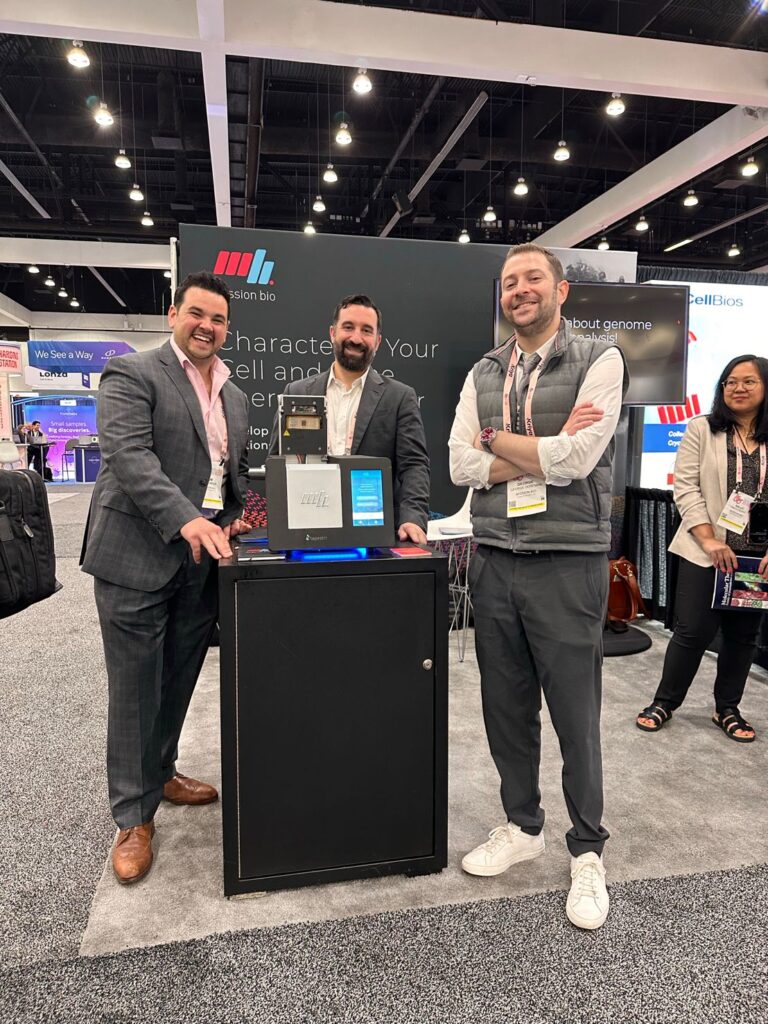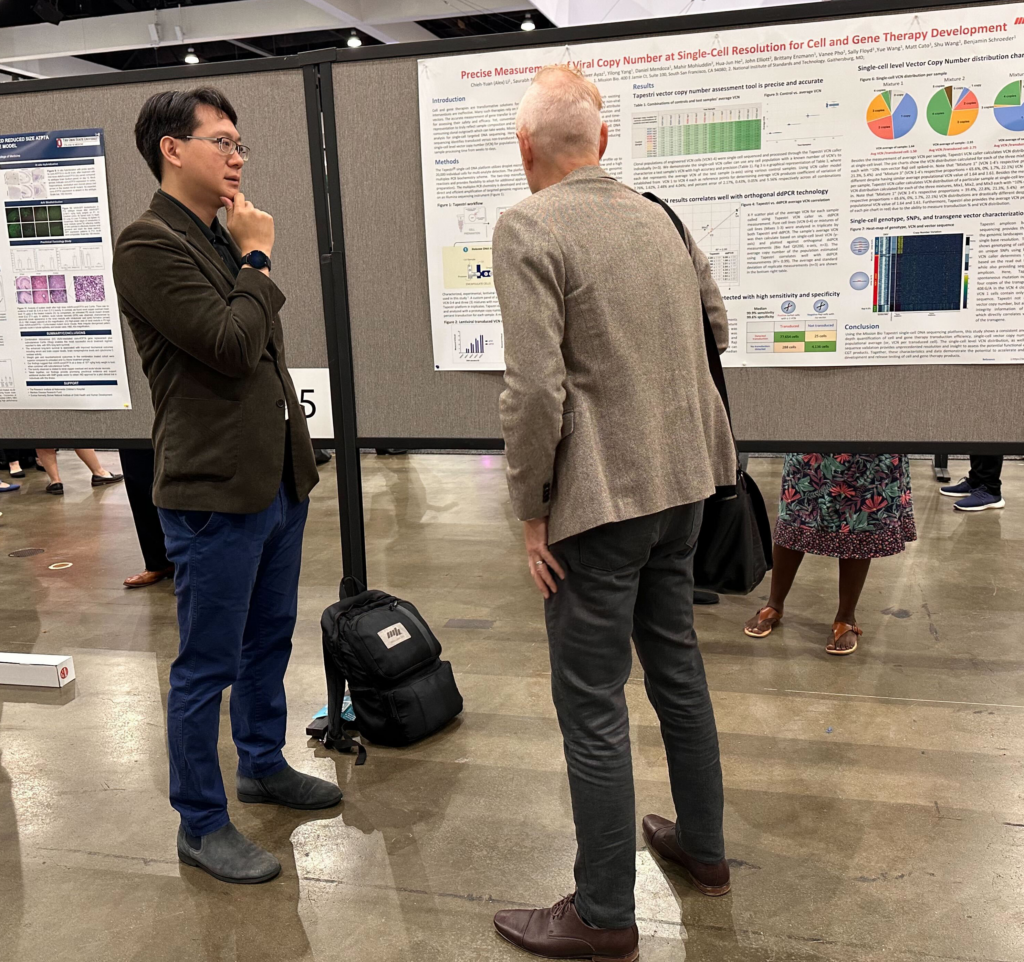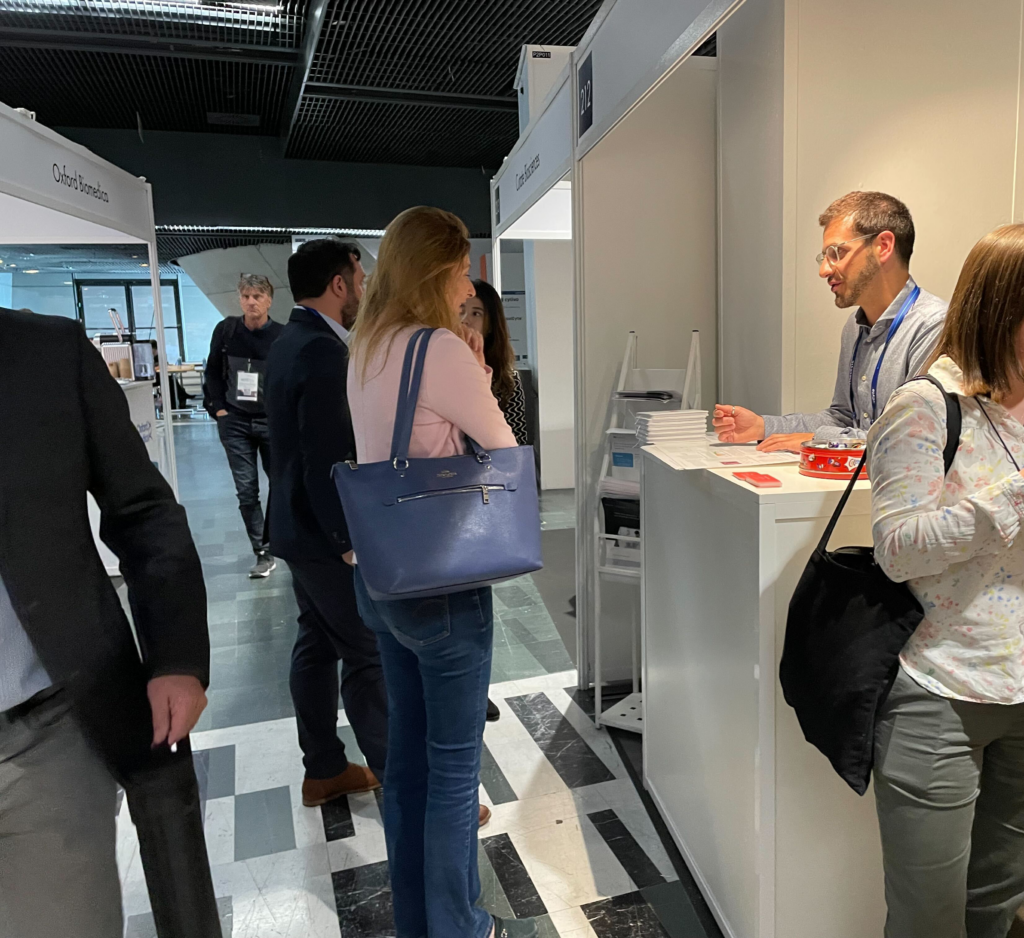This Mission Bio team was thrilled to get the 2023 scientific conference season into full swing. Two prominent conferences, the American Society of Gene and Cell Therapy (ASGCT), and the International Society for Cellular Therapy (ISCT) recently brought together experts in regenerative medicine, cellular therapies, and genetic engineering. We wanted to reflect on the key highlights and takeaways from these conferences, shedding light on the cutting-edge research and promising developments that were discussed.
ASGCT
This year’s ASGCT conference brought us to sunny Los Angeles, California. This major conference serves as a platform for experts in gene and cell therapy to exchange ideas, present breakthroughs, and discuss challenges in the field. 2023 brought forth several exciting developments:

The Mission Bio team ready to meet with ASGCT conference attendees
Gene Editing
Gene editing technologies were a prominent feature of many discussions, with presentations showcasing the progress made in gene editing approaches like CRISPR-Cas9, prime editing, and base editing. Advancements in delivery systems, in vivo cell engineering, and the treatments for cancer and monogenic diseases were also discussed. Vertex Therapeutic presented on the first CRISPR-based ex vivo cell therapy, Exa-cel, co-developed by CRISPR Therapeutics and Vertex. The developers of this promising therapy, which treats sickle-cell disease and B-thalassemia, submitted the BLA just this past April.
Several presentations on genome editing covered the topic of unwanted genomic alterations — a big concern when it comes to ensuring the safety of gene-edited therapeutics.
For instance, keynote speaker Jennifer Doudna delivered an insightful address entitled “CRISPR Chemistry and Applications in the Clinic,” speaking on the presence of chromosome loss in edited T cells. In her study, they used a 400-guide RNA library to cleave locations across the genome in T cells. The team found that on average ~3% of targeted cells had a whole or partial chromosome loss following editing — suggesting this is a general occurrence in T cells following CRISPR editing. Doudna then addressed the natural question of the clinical relevance of these events. She presented a comparison of a lab and clinical study where there was a difference in chromosome loss after T cell editing attributed to the difference to the order of which the T cells are activated and edited. This study and others like it contribute valuable information to reducing the risk of unwanted editing outcomes in therapeutic contexts.
Samantha Maragh, director at the National Institute of Standards and Technology presented the poster, “Outcomes from the First NIST Genome Editing Consortium Interlab Study.” This exciting study, led by the U.S. National Institute of Standards and Technology (NIST) Genome Editing Consortium includes experts across academia, industry, and government to collaboratively address genome editing measurements and standards needed to increase confidence in evaluating genome editing and utilizing these technologies in research and commercial products. In this initial study, NIST designed qualified mixture schemes consisting of DNA- or cell-based control samples to evaluate the accuracy of 14 participants’ reporting on the size, sequence, and frequency of the DNA variants. Dr. Maragh presented the participants’ data, which included data generated from Mission Bio’s Tapestri single-cell platform. Technologies evaluated included bulk DNA short read NGS, bulk DNA long read NGS, single cell targeted NGS, genome wide DNA imaging, targeted DNA probe imaging, and capillary electrophoresis fragment analysis. NIST is working on a database where all datasets, metadata, and results could be made publicly accessible.
Last but not least, Mission Bio debuted the Tapestri Genome Editing Solution, a groundbreaking product that will serve as a better analytical tool to develop next-generation gene-edited therapies by enabling single-cell insights that can impact both efficacy and safety. The solution will officially launch later this year.

Staff Scientist Alex Li discussing our Precise Measurement of Viral Copy Number at Single-Cell Resolution for Cell and Gene Therapy Development poster with conference attendees
Gene therapies for rare diseases
Researchers shared success stories of gene therapies for rare genetic diseases, emphasizing the positive impact these treatments have had on patients’ lives. The conference shed light on the importance of continued research, collaboration, and regulatory advancements to make these therapies more accessible and affordable.
Notable posters on this topic included progress on Intellia Therapeutics’ CRISPR-based drug for treating Hemophilia B.
Non-Viral Gene Delivery Systems
Overcoming challenges associated with viral vectors in gene therapy, non-viral delivery systems garnered significant attention. The conference showcased various non-viral approaches, including nanoparticle-based systems and CRISPR-mediated transfection, which hold promise for safer and more efficient gene delivery.
In her talk entitled “Cell Type-Programmable CRISPR-Cas9 Delivery Human T Cell Engineering,” Jennifer Hamilton addressed the question of whether we can engineer T cells within the body instead of outside of it (which is the conventional way of making CAR-T cells). She explained how Cas9-packaging enveloped delivery vehicles (Cas9-EDVs) with antibody fragments on their surface can be leveraged for cell-specific gene editing. Because the antibody fragments target specific cell-surface proteins, they can be designed to target T cells or other cells of interest for editing.
ISCT
The ISCT conference, held annually, focuses on the field of cellular therapy with an international audience. This year’s event held in Paris, France brought together experts from various disciplines, including immunology, transplantation, and stem cell research. Some noteworthy highlights from the conference include:
Advances in CAR-T Therapy
Chimeric Antigen Receptor T-cell (CAR-T) therapy has shown tremendous potential in treating certain types of cancer. Researchers at the ISCT conference presented updates on CAR-T clinical trials, discussing enhanced safety measures, improved manufacturing techniques, and strategies to overcome challenges related to supply chain, patient management, relapse and resistance. ISCT President Jacques Galipeau presented the presidential plenary address, “The Future of Immune Effector Cell Therapies for Cancer,” featuring Society leaders at the forefront of the cancer immunotherapy field. This opening session explored the state-of-the-art in CAR-based therapies and other novel technologies for liquid and solid cancers. Importantly, they spoke to persistent and emerging barriers to the successful adoption of these advanced therapies globally.

Field Application Scientist Matteo Cattaneo chatting with ISCT attendees
Mesenchymal Stem Cells (MSCs)
MSCs continue to be a topic of interest due to their regenerative properties. Researchers presented data on the therapeutic potential of MSCs in various applications, including tissue repair, organ bioengineering, immunomodulation, and neurological disorders. The conference highlighted ongoing efforts to optimize MSC manufacturing processes and improve their therapeutic efficacy.
Immune Cell Therapies
Novel approaches involving the modification of immune cells, such as natural killer (NK) cells and T-cell receptor (TCR) engineered cells, were discussed extensively. These therapies aim to harness the power of the immune system to combat cancer and other diseases. Discussions centered around advancements in novel engineering techniques, target selection, and clinical trial outcomes.
CGT learnings from conferences around the world
Attending conferences like ASGCT and ISCT provides a unique opportunity to witness the latest advancements and breakthroughs in the fields of cellular therapy, regenerative medicine, and gene therapy. The recent editions of these conferences have demonstrated the rapid pace of innovation in these areas, with researchers making significant strides towards improving patient outcomes and expanding the scope of treatments. As we reflect on the discussions and discoveries from these conferences, it becomes evident that the future of medicine is being shaped by the collective efforts of dedicated scientists and medical professionals.
Exciting times lie ahead as these advancements pave the way for a new era of personalized and transformative therapies. Our team hopes to see you out on the road later this year!










